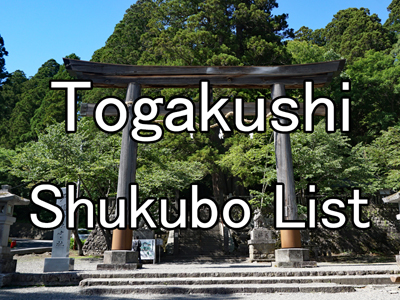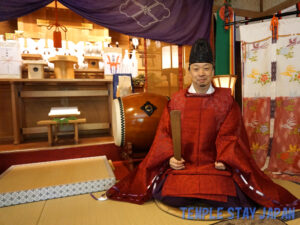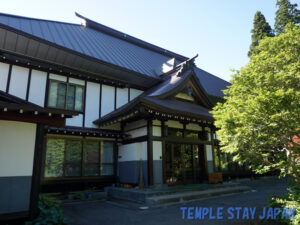Shukubo shrine stay
This is the shukubo where Shingen Takeda (1521-1573), a great feudal load and warrior prayed for victory.
The statues of two kites are placed at the entrance gate. These statues are said to have been built to guide the people inside according to an old story that Emperor Jinmu was guided by kites in his journey toward the East depicted in Kojiki (the oldest history book in Japan).
The shukubo is a beautiful example of Japanese style architecture and a neat and bright lobby spreads out in front of you when you enter. The rooms are equipped with a kotatsu heater, a heating device and a TV set. Yukata robes, towels and toothbrushes are also provided. There is a drying room for skiers. It takes ten minutes to get to the ski hill.
Togakushi’s Soba(buckwheat noodles dinner
I had Togakushi soba (buckwheat noodles) for dinner (on an all-you-can-eat soba plan). They served fresh soba noodles using soba harvested in their own fields. Its fragrance lightly stimulated my nose and the noodles were not too soft and were really tasty. I have eaten buckwheat noodles at some restaurants, but those served here were much tastier. (Of course, the noodles served in those restaurants were also good.) A shukubo staff member kindly told me a lot about the history of Togakushi and the shukubo and I really had a good time there.
Soba(Buckwheat noodles) making experience
Later, I experienced making buckwheat noodles. Let me explain. First, you mix buckwheat flour and wheat flour, add water and knead. Then, you make it round, just like you played with clay when you were a child. You have to knead it quickly before the “buckwheat catches a cold” according to the shukubo staff, so it was pretty difficult. I was not able to do it well and had to be helped by the shukubo staff.
Next, pour some flour called uchiko and spread it with a bar to spread it out thin. Spread the soba little by little so that it isn’t torn apart. Adjust the shape so as to form a circle. I managed to do this well. Then spray uchiko again and, finally, fold the sheet of buckwheat to make it ready to be cut by a knife.
Holding a pretty large and powerful looking knife, I was told not to cut my fingers. My legs trembled with tension. The knife was pretty heavy and so the effort required power. However, when a shukubo staff member showed us an example, he cut it unbelievably easily with little effort. (It may be natural for professional but it looked like the hand of god to me when I was making buckwheat noodles.)
My noodles were uneven in thickness, but I was relieved that I was able to somehow finish cutting them. Before I started to make them, I was worried that I wouldn’t be able to make anything edible, but thanks to the kind instruction of the shukubo staff, I was somehow able to make buckwheat noodles.
Then I boiled the noodles and ate them. They were truly fresh noodles. I was very moved by my own noodles, although I was thinking I should have cut them thinner. They sometimes stuck in my throat, but it was an experience unique to buckwheat noodle-making. I enjoyed the taste, which was of course that of Togakushi soba.










